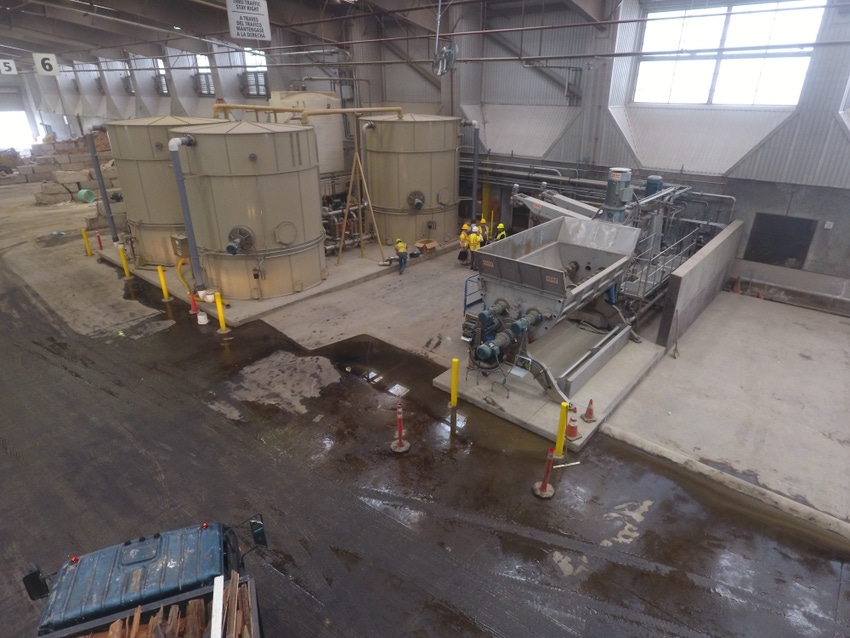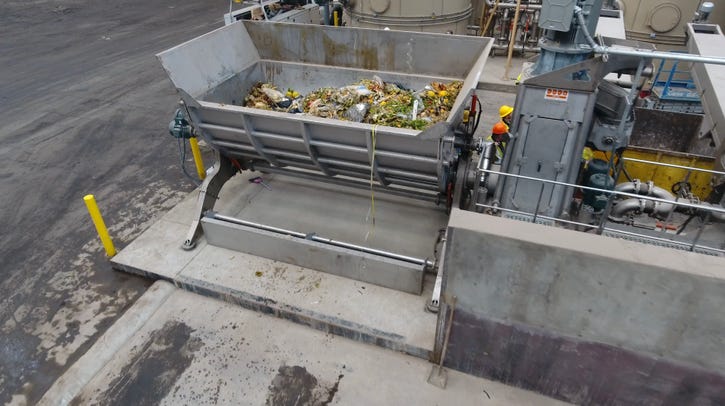Los Angeles to Combine Food Waste, Biosolids for Massive Energy Project
Currently, the system can process 165 tons per day of source separated food waste and should be able to digest 300 to 550 tons per day by 2020.

Los Angeles County Sanitation Districts (LACSD) is tapping into existing infrastructure at its wastewater treatment plant to be able to process food waste and convert it to renewable power or transportation fuel. Organics will be processed at its Puente Hills materials recovery facility (MRF), where contaminants will be removed, and a slurry will be created, pumped into tanks and shipped to the plant for co-digestion with biosolids.
“After vetting the concept through early research and then a successful demo with Waste Management, bringing in about 60 tons per day (tpd) of food waste, we determined that there’s market need and that the system works. We then embarked on a full-scale commercialization program,” says Mark McDannel, division engineer at LACSD’s Energy Recovery Section.
For now, the system can process 165 tpd of source separated food waste and should be able to digest 300 to 550 tpd by 2020 (out of 4,000 tpd of food waste generated in Los Angeles County). The operation is expected to generate up to 1,440 standard cubic feet per minute (SCFM) of biogas by 2020.
“We decided not to build a new digester at our solid waste facilities because we already had infrastructure at our wastewater treatment plant and could forgo high capital costs,” says McDannel.
But there was more about this model that seemed to make sense. The existing anaerobic digestion system, which converts food waste into methane gas in three weeks, also addresses a material stability issue.
“One challenge with digesters dedicated to food waste is that the composition of those materials is always changing, while sludge remains stable. We can add up to 30 percent food waste on a solids-to-solids basis, and the mix will remain stable,” says McDannel.
Research found that twice the methane can be generated with a 30 percent food mix over processing pure biosolids.

Plans moving forward are to process food waste for haulers and drive the slurry to the Joint Water Pollution Control Plant (JWPCP). Or waste companies can process it themselves and ship it to the MRF to be moved on to the plant. While LACSD has talked to haulers looking for different ways to process organics, there are no long-term signed contracts yet.
For now, the districts are taking about 100 tons a day to the treatment plant from haulers under short-term contracts.
“We are negotiating for larger, longer-term contracts, but it’s difficult because of uncertainty around when SB 1383 rules [around organics diversion] will be finalized and enforced. Plus, the market is not mature yet,” explains McDannel.
LACSD will develop and own the energy project. The treatment plant will take digested gas for its electricity needs. LACSD will deliver excess power into the grid.
The phase one project will take 400 of the 1,400 SCFM of digester gas that the operation will ultimately generate. That 400 SCFM will produce about 2,500 gasoline gallon equivalents per day of compressed natural gas vehicle fuel. The remaining gas will make electricity.

Phase 2, which would use additional gas, is currently being evaluated.
“Renewable natural gases are high for now, and private developers are building projects fast. Renewable Identification Numbers (RINs) and the low-carbon fuel standard help, but my personal take is supply will catch up to demand, and high prices are not here for the long term. But this is a 15- to 20-year project. So, we can look at electricity [which has low prices now] in addition to RNG,” says McDannel.
Los Angeles County Public Works is offering subsidies to haulers to take their organics to LACSD’s Puente Hills MRF for processing. To achieve aggressive waste diversion goals, the county promotes alternative technologies to divert from landfill and create renewable energy and beneficial products.
“We are providing this subsidy to participating commercial waste haulers to allow them to offer the service at no additional cost in order to spur the marketplace and test new and innovative waste collection and recycling methods,” says Coby Skye, assistant deputy director for Los Angeles County Public Works.
“Leveraging the most efficient and cost-effective ways to collect and recycle food waste will help the county meet its landfill diversion targets as well as help businesses and the county comply with state law and regulations,” he says.
About the Author(s)
You May Also Like




